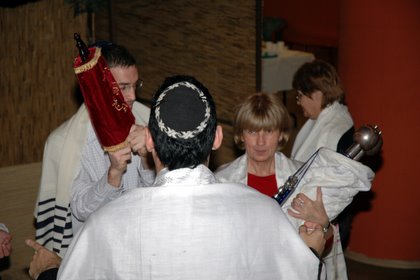Rabbi Morgan was an early supporter of Sim Shalom when he was based in Weybridge, UK, while also being personal mentor of our rabbi Katalin Kelemen.
This article was taken from WUPJ newsletter, original can be found here:
http://www.wupj.org/Publications/Newsletter.asp?ContentID=465
Torah from around the world #79
Parashat Shoftim (Deuteronomy 16:18-21:9)
by Rabbi Fred Morgan, Senior Rabbi, Temple Beth Israel, Melbourne, Australia
During the coming week Australia will be holding its next national census. The results are used to set governmental targets and spending priorities for the next five years, as well as keep statisticians and social commentators in business for many decades.
All countries and communities use censuses to predict trends and plan for the future. Censuses are especially pertinent to the Jewish community. Being such a small community globally and locally in Australia (0.5% of the national population), we need to have as much information about ourselves as possible in order to provide for our survival, or what has come to be labeled “Jewish continuity.”
Recently scholars at Monash University combined the results of the last Australian census five years ago with an intensive survey of the Jewish community to produce an in-depth study of Jewish continuity in this country. The results, meticulously documented, probably correspond to the outcomes of studies in other countries around the globe, as well as what our intuition would tell us. But these insights are now grounded in facts and figures.
According to the survey, the principal threats to Jewish continuity are these:
- Intermarriage largely due to people marrying later and thus no longer keen or able to find partners within their primary social cohort (school, shul and youth group), which tends to be Jewish;
- Economic transformations that make it difficult for young Jewish adults to purchase homes in traditional areas of Jewish settlement;
- The ageing profile of the baby-boomer generation and the social and economic burdens this places on the community at large;
- Gen Y’s alienation from the ideological commitments of the previous generation, including their passive refusal to give unquestioning support to Israel;
- Plummeting rates of observance among the majority of Jews, and the ever-widening gulf between the ultra-frum and the secular;
- The prevalence of “traditional non-observant” Jews within the community, unlike the situation in America, forming a majority that has little sense of direction or purpose beyond calling itself Orthodox.
There are no surprises here.
I give full credit to the scholars who put together this study. They’ve done a great job. Now, what do we do with the results?
The temptation is to tackle the issues head-on. For example, we might respond by trying to create more opportunities for our 30-year-old adults to meet other Jews, intensifying our talk about Israel within the community, building more aged care facilities for the baby-boomers to fill, becoming more pluralistic or multiform in order to fill the religious middle ground and bridge the gap between the ultra-observant and secular alternatives.
All of these are reasonable, functional responses to the issues surrounding Jewish continuity. But there is another approach as well, an approach that does not focus on the problems and their solutions per se but comes from a different angle. After all, it is hard to find inspiration in seeking repetitive solutions to what are, after all, age-old problems. How many among the Generation X client group really care about solving the ‘problem’ of intermarriage? How many apart from those who self-consciously fall in the middle are interested in bridging the gap between ultra-frum and secular? I’d like instead to look at whatever it is that inspires us from our tradition and view those actions as a way of creating a sense of Jewish continuity that is meaningful rather than simply functional.
I find this kind of inspiration in this week’s Torah portion, Shoftim. The themes in Shoftim do not deal with Jewish continuity. Rather, they deal with tzedek, with justice. They raise central questions about how a human society works, about the nature of authority, intentional or presumptuous harm and coincidental harm, protecting the environment in times of war, facing up to the corruption of death and destructive elements in society. If we translate these concerns into practical ethics, into social action, then we put the passions that we Jews so often feel into a Jewish framework, the framework of Torah, and we ignite a fire for justice in Jews who otherwise ask: What is the point of Jewish continuity? Why should we survive? Why shout, Am Yisrael Chai!, if it is not linked to bringing justice into the world in which we live?
I’d like to suggest that those communities that have a strong, outward-looking social action focus do not need to talk endlessly about Jewish continuity. They are living out continuity in a meaningful way. Conversely, those communities that do not have a strong social action focus, like the Australian Jewish community and many others in Europe and elsewhere, are floundering in their search for meaning.
Shoftim opens with the famous phrase, Tzedek tzedek tirdof, Justice, justice shall you pursue. The rabbis ask: Why is the word tzedek, justice, repeated? They offer many explanations. A bat-mitzvah student recently made a suggestion that is filled with wisdom. She noticed that the words tzedek and tzaddik are related, and she went on to explain: the first tzedek refers to the rules of justice, the mitzvot, contained in our portion. They tell us what to do, but we have no say in them. They may compel us to act, but they don’t inspire us, and eventually we may stop paying attention to them. The second tzedek comes into play when we internalize the rules, when they become a part of us. Then, we ourselves are tzedek; we are, each of us, a tzaddik, a mensh. We start by doing; then, we become what we do. Shoftim teaches us how to do as Jews, to make a real difference in the world by striving to become tzaddikim; Jewish continuity follows from that.

